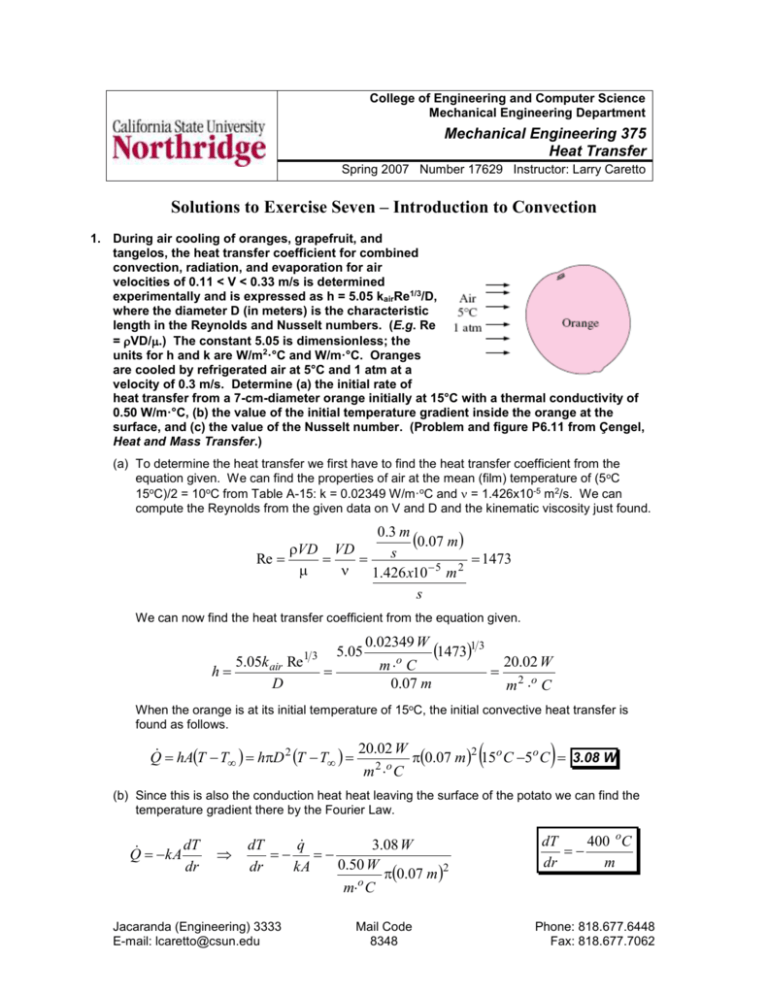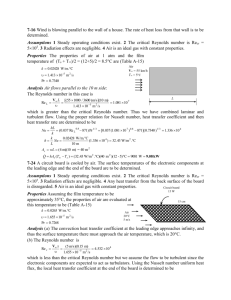Unit 7: March 19
advertisement

College of Engineering and Computer Science Mechanical Engineering Department Mechanical Engineering 375 Heat Transfer Spring 2007 Number 17629 Instructor: Larry Caretto Solutions to Exercise Seven – Introduction to Convection 1. During air cooling of oranges, grapefruit, and tangelos, the heat transfer coefficient for combined convection, radiation, and evaporation for air velocities of 0.11 < V < 0.33 m/s is determined experimentally and is expressed as h = 5.05 kairRe1/3/D, where the diameter D (in meters) is the characteristic length in the Reynolds and Nusselt numbers. (E.g. Re = VD/.) The constant 5.05 is dimensionless; the units for h and k are W/m2·°C and W/m·°C. Oranges are cooled by refrigerated air at 5°C and 1 atm at a velocity of 0.3 m/s. Determine (a) the initial rate of heat transfer from a 7-cm-diameter orange initially at 15°C with a thermal conductivity of 0.50 W/m·°C, (b) the value of the initial temperature gradient inside the orange at the surface, and (c) the value of the Nusselt number. (Problem and figure P6.11 from Çengel, Heat and Mass Transfer.) (a) To determine the heat transfer we first have to find the heat transfer coefficient from the equation given. We can find the properties of air at the mean (film) temperature of (5 oC 15oC)/2 = 10oC from Table A-15: k = 0.02349 W/m·oC and = 1.426x10-5 m2/s. We can compute the Reynolds from the given data on V and D and the kinematic viscosity just found. 0.3 m 0.07 m VD VD s Re 1473 1.426 x10 5 m 2 s We can now find the heat transfer coefficient from the equation given. 5.05k air Re h D 13 5.05 0.02349 W m C 0.07 m o 14731 3 20.02 W m 2 o C When the orange is at its initial temperature of 15oC, the initial convective heat transfer is found as follows. 20.02 W Q hAT T hD 2 T T 2 o 0.07 m2 15o C 5o C 3.08 W m C (b) Since this is also the conduction heat heat leaving the surface of the potato we can find the temperature gradient there by the Fourier Law. dT Q kA dr dT q 3.08 W 0.50 W dr kA 0.07 m 2 o m C Jacaranda (Engineering) 3333 E-mail: lcaretto@csun.edu Mail Code 8348 dT 400 oC dr m Phone: 818.677.6448 Fax: 818.677.7062 Exercise seven solutions ME 375, L. S. Caretto, Spring 2007 Page 2 (c) We are told that the characteristic length is the diameter so the Nusselt number is Nu = hD/k for this problem. 0.07 m hD m 2 o C 0.02349 W k m o C 20.02 W Nu Nu = 57.5 2. A long 8-cm-diameter steam pipe whose external surface temperature is 90°C passes through some open area that is not protected against the winds. Determine the rate of heat loss from the pipe per unit of its length when the air is at 1 atm pressure and 7°C and the wind is blowing across the pipe at a velocity of 50 km/h. The average heat transfer coefficient for flow over a cylinder is found from the following equation where the characteristic distance in the Reynolds and Nusselt numbers is the cylinder diameter, D. 58 0.62 Re 0.5 Pr1 3 Re 1 Nu 0.3 14 282,000 1 0.4 Pr 2 3 45 We first have to find the properties for air at the mean temperature of (90oC + 7oC)/2 = 48.5oC from Table A-15: k = 0.02724 W/m·K, n = 1.784x10-5 m2/s, and Pr = 0.7232. The Reynolds number is Re VD VD 50 km 1 h 1000 m 0.08 m h 3600 s km 1.426 x10 s 5 m 2 6.228 x10 4 From the equation given for the heat Nusselt number, we find hD 0.62 Re 0.5 Pr1 3 Nu 0.3 14 k 1 0.4 Pr 2 3 0.3 Re 5 8 1 282,000 0.72321 3 1 6.228 x10 4 1 0.4 0.72322 3 1 4 282,000 0.62 6.228 x10 4 0.5 45 5 8 4 5 159.1 We can compute the heat transfer coefficient from the Nusselt number. 0.02724 W k Nu h D 159.1 54.17 W m o C 2 o 0.08 m m C The heat transfer is given by the usual convection equation, which we can solve for the heat transfer per unit length. hAT T hDL T T Q hDT T L Exercise seven solutions ME 375, L. S. Caretto, Spring 2007 Q 54.17 W hDT T 2 o 0.08 m 90o C 7 o C L m C Page 3 Q 1130 W L m 3. Repeat problem 2 using water instead of air as the flowing fluid. We first have to find the properties for air at the mean temperature of (90oC + 7oC)/2 = 48.5oC from Table A-9: k = 0.641 W/m·K, = 5.682x10-7 m2/s, and Pr = 3.782. The Reynolds number is Re VD VD 50 km 1 h 1000 m 0.08 m h 3600 s km 5.682 x10 s 7 m 2 1.956 x10 6 From the equation given for the heat Nusselt number, we find hD 0.62 Re 0.5 Pr1 3 Nu 0.3 14 k 1 0.4 Pr 2 3 0.3 0.62 1.956 x10 6 0.5 3.782 13 1 0.4 3.782 2314 Re 5 8 1 282,000 6 5 8 1 1.956 x10 282,000 45 45 1104 We can compute the heat transfer coefficient from the Nusselt number. 1104 o k Nu 8848 W m C h 2 o D 0.08 m m C 0.641 W Substitute the results for this problem into the equation for heat transfer per unit length from problem 2. Q 8848 W hDT T 2 o 0.08 m 90o C 7 o C L m C Q 184,564 W L m For the same flow conditions, the convection heat transfer with water is much higher than that with air.











